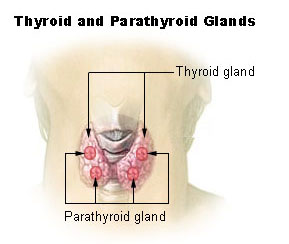|
|
| Line 16: |
Line 16: |
| {{CMG}} | | {{CMG}} |
|
| |
|
| ==Overview==
| |
| '''Primary hyperparathyroidism''' causes [[hypercalcemia]] (elevated blood calcium levels) through the excessive secretion of [[parathyroid hormone]] (PTH), usually by an [[adenoma]] (benign tumors) of the [[parathyroid gland]]s. Its incidence is approximately 42 per 100,000 people. It is almost exactly three times as common in women as men.
| |
|
| |
|
| ==Signs and Symptoms==
| |
| The signs and symptoms of primary hyperparathyroidism are those of hypercalcemia. They are classically summarized by the mnemonic "stones, bones, abdominal groans and psychic moans".
| |
| * "Stones" refers to [[kidney stones]], [[nephrocalcinosis]], and [[diabetes insipidus]] (polyuria and polydipsia). These can ultimately lead to [[renal failure]].
| |
| * "Bones" refers to bone-related complications. The classic bone disease in hyperparathyroidism is [[osteitis fibrosa cystica]], which results in pain and sometimes pathological fractures. Other bone diseases associated with hyperparathyroidism are [[osteoporosis]], [[osteomalacia]], and [[arthritis]].
| |
| * "Abdominal groans" refers to gastrointestinal symptoms of [[constipation]], [[indigestion]], [[nausea]] and [[vomiting]]. Hypercalcemia can lead to [[peptic ulcers]] and [[acute pancreatitis]].
| |
| * "Psychic moans" refers to effects on the [[central nervous system]]. Symptoms include lethargy, fatigue, depression, memory loss, psychosis, ataxia, delirium, and coma.
| |
| * [[Left ventricular hypertrophy]].<ref>{{cite journal |author=Stefenelli T, Abela C, Frank H, ''et al'' |title=Cardiac abnormalities in patients with primary hyperparathyroidism: implications for follow-up |journal=J. Clin. Endocrinol. Metab. |volume=82 |issue=1 |pages=106-12 |year=1997 |pmid=8989242 |doi= |url=http://jcem.endojournals.org/cgi/content/full/82/1/106}}</ref>
| |
|
| |
| Other signs include proximal muscle weakness, itching, and band [[keratopathy]] of the eyes.
| |
|
| |
| ==Diagnosis==
| |
| The diagnosis of primary hyperparathyroidism is made by blood tests. Serum calcium levels are elevated.
| |
|
| |
| ==Complications==
| |
| The classic bone disease in hyperparathyroidism is [[osteitis fibrosa cystica]], which results in pain and sometimes pathological fractures. Other bone diseases associated with hyperparathyroidism are [[osteoporosis]], [[osteomalacia]], and [[arthritis]].
| |
|
| |
| ==Treatment==
| |
| Treatment is usually surgical removal of the gland(s) containing adenomas.
| |
|
| |
| ===Medications===
| |
| Medications include estrogen replacement therapy in postmenopausal women and [[bisphosphonate]]s. [[Bisphosphonate]]s may improve bone turnover.<ref name="pmid15240609">{{cite journal |author=Khan AA, Bilezikian JP, Kung AW, ''et al'' |title=Alendronate in primary hyperparathyroidism: a double-blind, randomized, placebo-controlled trial |journal=J. Clin. Endocrinol. Metab. |volume=89 |issue=7 |pages=3319-25 |year=2004 |pmid=15240609 |doi=10.1210/jc.2003-030908}}</ref>
| |
|
| |
| ===Surgery===
| |
|
| |
|
| ==Related Chapters== | | ==Related Chapters== |
